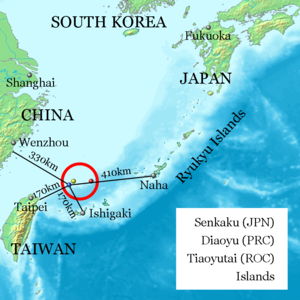
Back Anghydfod Ynysoedd Senkaku Welsh Disputa territorial de las Islas Senkaku Spanish مناقشه جزایر سنکاکو Persian Conflit territorial des îles Senkaku French סכסוך איי סנקאקו HE Persengketaan Kepulauan Tiaoyutai ID Crisi sino-giapponese per le isole Senkaku Italian 尖閣諸島問題 Japanese 센카쿠 열도 분쟁 Korean Tuntutan bertindih mengenai Kepulauan Senkaku Malay
This article contains too many or overly lengthy quotations. (December 2024) |
The Senkaku Islands dispute, or Diaoyu Islands dispute, is a territorial dispute over a group of uninhabited islands known as the Senkaku Islands in Japan, the Diaoyu Islands in China,[1] and Tiaoyutai Islands in Taiwan.[2] Aside from a 1945 to 1972 period of administration by the United States as part of the Ryukyu Islands, the archipelago has been controlled by Japan since 1895.[3] The territory is close to key shipping lanes and rich fishing grounds, and there may be oil reserves in the area.[4]
According to Lee Seokwoo, China started taking up the question of sovereignty over the islands in the latter half of 1970 when evidence relating to the existence of oil reserves surfaced.[5] Taiwan also claims the islands.
Japan argues that it surveyed the islands in the late 19th century and found them to be terra nullius (Latin: land belonging to no one); subsequently, China acquiesced to Japanese sovereignty until the 1970s. The PRC and the ROC argue that documentary evidence prior to the First Sino-Japanese War indicates Chinese possession and that the territory is accordingly a Japanese seizure that should be returned as the rest of Imperial Japan's conquests were returned in 1945.
The islands are included within the Treaty of Mutual Cooperation and Security between the United States and Japan, meaning that a defense of the islands by Japan would require the United States to come to Japan's aid.[6]
In September 2012, the Japanese government purchased three of the disputed islands from their private owner, prompting large-scale protests in China[7] and Taiwan. Although Japan viewed its move as an attempt to defeat Tokyo governor Shintaro Ishihara's more provocative attempt to buy the islands to develop infrastructure on them, the Chinese side viewed the purchase as an effort by Japan to bring the islands under Japanese sovereignty.[8]
On 23 November 2013, the PRC set up the East China Sea Air Defense Identification Zone which includes the Senkaku Islands, and announced that it would require all aircraft entering the zone to file a flight plan and submit radio frequency or transponder information.
- ^ Ogura, Junko (14 October 2010). "Japanese party urges Google to drop Chinese name for disputed islands". US: CNN. Archived from the original on 4 October 2012.
- ^ Kristof, Nicholas (10 September 2010). "Look Out for the Diaoyu Islands". The New York Times. Archived from the original on 20 October 2012. Retrieved 15 August 2012.
- ^ JOHN W. FINNEY Special to The New York Times (11 November 1971). "SENATE ENDORSES OKINAWA TREATY – Votes 84 to 6 for Island's Return to Japan – Rioters There Kill a Policeman Senate, in 84 to 6 Vote, Approves the Treaty Returning Okinawa to Japan – Front Page". The New York Times. Archived from the original on 23 July 2018. Retrieved 20 August 2012.
- ^ "Q&A: China-Japan islands row" Archived 10 July 2018 at the Wayback Machine BBC News 11 September 2012
- ^ Lee, Seokwoo et al. (2002). Territorial disputes among Japan, Taiwan and China concerning the Senkaku Islands, pp. 11–12., p. 11, at Google Books
- ^ "U.S. says Senkaku Islands fall within scope of Japan-U.S. security treaty". Kyodo News. Archived from the original on 15 July 2012. Retrieved 20 August 2012.
- ^ "China protests over Japanese activists' visit to disputed island". the Guardian. 19 August 2012. Archived from the original on 23 March 2023. Retrieved 9 January 2023.
- ^ Cite error: The named reference
:1was invoked but never defined (see the help page).

